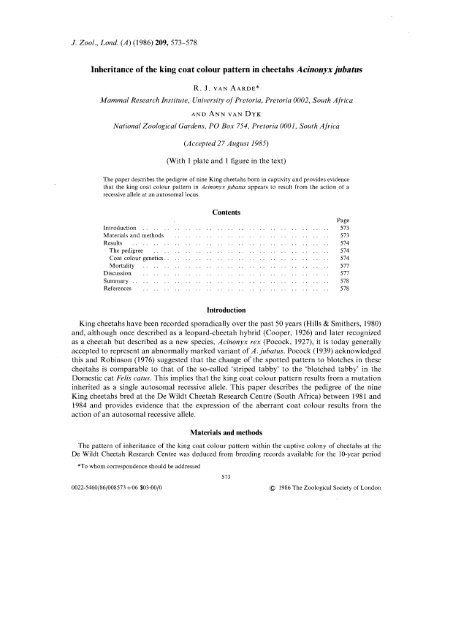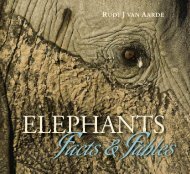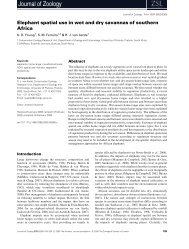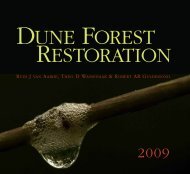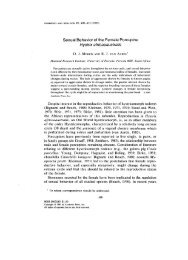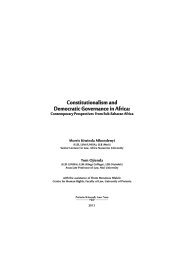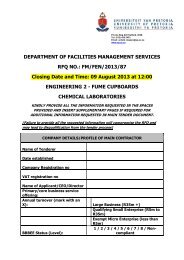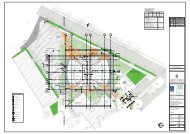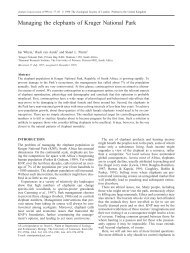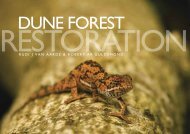Inheritance of the king coat colour pattern in cheetahs ... - CERU
Inheritance of the king coat colour pattern in cheetahs ... - CERU
Inheritance of the king coat colour pattern in cheetahs ... - CERU
Create successful ePaper yourself
Turn your PDF publications into a flip-book with our unique Google optimized e-Paper software.
1. Zool., Lond. (A) (1986) 209, 573-578<br />
<strong>Inheritance</strong> <strong>of</strong> <strong>the</strong> <strong>k<strong>in</strong>g</strong> <strong>coat</strong> <strong>colour</strong> <strong>pattern</strong> <strong>in</strong> <strong>cheetahs</strong> Ac<strong>in</strong>onyx jubatus<br />
R. 1. VAN AARDE*<br />
Mammal Research Institute, University <strong>of</strong> Pretoria, Pretoria 0002, South Africa<br />
AND ANN VAN DYK<br />
National Zoological Gardens, PO Box 754, Pretoria 0001, South Africa<br />
(Accepted 27 August 1985)<br />
(With 1 plate and 1 figure <strong>in</strong> <strong>the</strong> text)<br />
The paper describes <strong>the</strong> pedigree <strong>of</strong> n<strong>in</strong>e K<strong>in</strong>g <strong>cheetahs</strong> born <strong>in</strong> captivity and provides evidence<br />
that <strong>the</strong> <strong>k<strong>in</strong>g</strong> <strong>coat</strong> <strong>colour</strong> <strong>pattern</strong> <strong>in</strong> Ac<strong>in</strong>onyx jubatus appears to result from <strong>the</strong> action <strong>of</strong> a<br />
recessive allele at an autosomal locus.<br />
Contents<br />
Page<br />
Introduction 573<br />
Materials and methods 573<br />
Results ....... . 574<br />
The pedigree 574<br />
Coat <strong>colour</strong> genetics .. 574<br />
Mortality 577<br />
Discussion 577<br />
Summary .. .. . . . . 578<br />
References 578<br />
Introduction<br />
K<strong>in</strong>g <strong>cheetahs</strong> have been recorded sporadically over <strong>the</strong> past 50 years (Hills & Smi<strong>the</strong>rs, 1980)<br />
and,.although once described as a leopard-cheetah hybrid (Cooper, 1926) and later recognized<br />
as a chectah but described as a ncw species, Ac<strong>in</strong>onyx rex (Pocock, 1927), it is today generally<br />
accepted to represent an abnormally marked variant <strong>of</strong> A.jubatus. Pocock (1939) acknowledgcd<br />
this and Rob<strong>in</strong>son (1976) suggested that <strong>the</strong> change <strong>of</strong> <strong>the</strong> spotted <strong>pattern</strong> to blotches <strong>in</strong> <strong>the</strong>se<br />
<strong>cheetahs</strong> is comparable to that <strong>of</strong> <strong>the</strong> so-called 'striped tabby' to <strong>the</strong> 'blotched tabby' <strong>in</strong> thc<br />
Domestic cat Felis catus. This implies that thc <strong>k<strong>in</strong>g</strong> <strong>coat</strong> <strong>colour</strong> <strong>pattern</strong> results from a mutation<br />
<strong>in</strong>herited as a s<strong>in</strong>gle autosomal recessive allele. This paper describes <strong>the</strong> pedigree <strong>of</strong> <strong>the</strong> n<strong>in</strong>e<br />
K<strong>in</strong>g <strong>cheetahs</strong> bred at <strong>the</strong> De Wildt Cheetah Research Centre (South Africa) between 1981 and<br />
1984 and provides evidence that <strong>the</strong> expression <strong>of</strong> <strong>the</strong> aberrant <strong>coat</strong> <strong>colour</strong> results from <strong>the</strong><br />
action <strong>of</strong> an autosomal recessive allele.<br />
Materials and methods<br />
The <strong>pattern</strong> <strong>of</strong> <strong>in</strong>heritance <strong>of</strong> <strong>the</strong> <strong>k<strong>in</strong>g</strong> <strong>coat</strong> <strong>colour</strong> pattcrn with<strong>in</strong> <strong>the</strong> captive colony <strong>of</strong> <strong>cheetahs</strong> at <strong>the</strong><br />
De Wildt Cheetah Research Centre was deduced from breed<strong>in</strong>g records available for <strong>the</strong> lO-year period<br />
*To whom correspondence should be addressed<br />
573<br />
0022-5460/86/008573 +06 $0300/0 © 1986 Thc Zoological Society <strong>of</strong> London
574 R.1. VAN AARDE AND ANN VAN DYK<br />
from 1975 to 1984. Husbandry and breed<strong>in</strong>g <strong>of</strong><strong>cheetahs</strong> at <strong>the</strong> Centre has been described elsewhere (Brand,<br />
1980). The breed<strong>in</strong>g system, where females were isolated from males except for mat<strong>in</strong>g purposes, provided<br />
<strong>the</strong> opportunity to select artificially breed<strong>in</strong>g pairs. Suspected pregnant females were each housed separately<br />
<strong>in</strong> maternity enclosures after mat<strong>in</strong>g with a selected male. Males did not rega<strong>in</strong> access to <strong>the</strong>se females<br />
until <strong>the</strong> onset <strong>of</strong> <strong>the</strong> Collow<strong>in</strong>g mat<strong>in</strong>g season, thus ensur<strong>in</strong>g <strong>the</strong> planned parentage <strong>of</strong> litters.<br />
Shelters with<strong>in</strong> each maternity enclosure were <strong>in</strong>spected daily for <strong>the</strong> presence <strong>of</strong> cubs or aborted foetuses,<br />
or any o<strong>the</strong>r signs oCparturition, and <strong>the</strong> dates, sex composition and <strong>coat</strong> <strong>colour</strong>s <strong>of</strong> all litters were recorded<br />
where possible. Cheetahs with a spotted <strong>coat</strong> <strong>colour</strong> <strong>pattern</strong> will, for <strong>the</strong> purpose <strong>of</strong> this discussion, be<br />
referred to as <strong>the</strong> 'wild type' and those with a blotched <strong>coat</strong> <strong>colour</strong> <strong>pattern</strong>, as '<strong>k<strong>in</strong>g</strong>s'.<br />
Results<br />
The pedigree<br />
The coa t <strong>colour</strong> <strong>pattern</strong>s <strong>of</strong> <strong>the</strong> n<strong>in</strong>e K<strong>in</strong>g <strong>cheetahs</strong> are very different to those <strong>of</strong> <strong>the</strong> wild type<br />
(Plate I), but similar to those <strong>of</strong> <strong>the</strong> study sk<strong>in</strong>s <strong>of</strong> A. rex, as described and illustrated by Hills &<br />
Smi<strong>the</strong>rs (1980). These were all characterized by <strong>the</strong> partial replacement <strong>of</strong> <strong>the</strong> normal spots by<br />
broad bands form<strong>in</strong>g whorls and spiral arrangements similar to tbose occurr<strong>in</strong>g <strong>in</strong> <strong>the</strong> blotched<br />
tabby Domestic cal.<br />
The pedigrees <strong>of</strong> <strong>the</strong> n<strong>in</strong>e K<strong>in</strong>g cbeetahs produced are illustrated <strong>in</strong> Fig. 1. The three wild type<br />
mo<strong>the</strong>rs <strong>in</strong>volved orig<strong>in</strong>ated from two consecutive litters produced by a wild type male (Chris)<br />
and female (Lady) caught <strong>in</strong> SWAjNamibia and <strong>the</strong> nor<strong>the</strong>rn TransvaaL South Africa, respectively.<br />
One <strong>of</strong> <strong>the</strong> three wild type males (Frik), which sired K<strong>in</strong>g <strong>cheetahs</strong>, was similarly captured<br />
as a free-rang<strong>in</strong>g animal <strong>in</strong> <strong>the</strong> nor<strong>the</strong>rn TransvaaL The o<strong>the</strong>r two males (Ben and M35) were<br />
born follow<strong>in</strong>g mat<strong>in</strong>gs between Prik and a wild type female (Gill), caught <strong>in</strong> <strong>the</strong> eastern<br />
TransvaaL<br />
Mat<strong>in</strong>gs between <strong>the</strong> wild type male Frik and two <strong>of</strong> <strong>the</strong> wild type daughters (Jean and Jumper)<br />
resulted <strong>in</strong> <strong>the</strong> birth <strong>of</strong> two K<strong>in</strong>g <strong>cheetahs</strong>. All <strong>the</strong> o<strong>the</strong>r K<strong>in</strong>g <strong>cheetahs</strong> were conceived<br />
by mat<strong>in</strong>g his male wild type progeny (Ben and M35) with <strong>the</strong> wild type females, Jean and F20<br />
(pig. 1).<br />
A mat<strong>in</strong>g between Prik and Lady (wild type, wild caught mo<strong>the</strong>r <strong>of</strong> three sibl<strong>in</strong>gs which <strong>in</strong><br />
turn produced K<strong>in</strong>g <strong>cheetahs</strong>) did not produce a K<strong>in</strong>g. This suggests that Lady was not a carrier<br />
<strong>of</strong> tbe '<strong>k<strong>in</strong>g</strong>' trait and <strong>in</strong>dicates that her daughters <strong>in</strong>herited <strong>the</strong> cbaracter from <strong>the</strong> fatber, Cbris.<br />
It sbould, however, be noted that <strong>the</strong>se data do not preclude Lady from be<strong>in</strong>g a carrier.<br />
Coat <strong>colour</strong> genetics<br />
The bypo<strong>the</strong>sis that <strong>the</strong> '<strong>k<strong>in</strong>g</strong>' pbenotype results from a s<strong>in</strong>gle autosomal recessive mutation is<br />
supported by <strong>the</strong> fact tbat K<strong>in</strong>g cbeetabs <strong>of</strong> both sexes were produced by wild type parents and<br />
<strong>of</strong>fspr<strong>in</strong>g <strong>of</strong> tbese wild type parents. If <strong>the</strong> '<strong>k<strong>in</strong>g</strong>' phenotype results from a mutation <strong>of</strong> a gene<br />
locus, homologous to <strong>the</strong> tabby locus <strong>in</strong> <strong>the</strong> Domestic cat, it is expected that <strong>the</strong> <strong>pattern</strong> <strong>of</strong><br />
<strong>in</strong>heritance would be similar to tbat <strong>of</strong> <strong>the</strong> blotched tabby <strong>pattern</strong> and thus typical <strong>of</strong> a s<strong>in</strong>gle<br />
autosomal recessive gene.<br />
In designat<strong>in</strong>g <strong>the</strong> '<strong>k<strong>in</strong>g</strong>' character as tb and its dom<strong>in</strong>ant allele as t + , it follows that all K<strong>in</strong>g<br />
<strong>cheetahs</strong> must be <strong>of</strong> <strong>the</strong> genotype tbt b and wild types ei<strong>the</strong>r /+ /" or t+ t+. K<strong>in</strong>g <strong>cheetahs</strong> will<br />
only be produced by t+tb or {btb parents and wild type carriers by mat<strong>in</strong>gs between /+/+ and<br />
t+ tb or t+ tb and t+ tb or t+ tb and tbtb parents.
INHERITANCE OF KING COAT COLOUR<br />
575<br />
PLATE I. The first K<strong>in</strong>g cheetah produced at <strong>the</strong> Dc Wildt Cheetah Research Centre.<br />
The ratio <strong>of</strong> K<strong>in</strong>g <strong>cheetahs</strong> to wild type progeny result<strong>in</strong>g from rna t<strong>in</strong>gs between <strong>the</strong> different<br />
genotypes is <strong>in</strong> accordance (x 2 = O· 32) with <strong>the</strong> hypo<strong>the</strong>sis <strong>of</strong> a s<strong>in</strong>gle autosomal gene, where<br />
<strong>the</strong> mutant allele '<strong>k<strong>in</strong>g</strong>' is recessive to <strong>the</strong> wild type allele (Table I).<br />
S<strong>in</strong>ce <strong>the</strong> grandparcnts <strong>of</strong> <strong>the</strong> K<strong>in</strong>g <strong>cheetahs</strong> failed to produce <strong>the</strong> <strong>k<strong>in</strong>g</strong> <strong>coat</strong> <strong>colour</strong>, we suggest<br />
that each <strong>of</strong> <strong>the</strong>se orig<strong>in</strong>al mat<strong>in</strong>gs <strong>in</strong>volved a t+ t+ and t + tb <strong>in</strong>dividual. Early deaths precluded<br />
test-cross<strong>in</strong>g to prove this, but at least one <strong>of</strong> <strong>the</strong>se males (Frik), was, through his production <strong>of</strong><br />
K<strong>in</strong>g <strong>cheetahs</strong>, positively identified as heterozygous for this character. At least two <strong>of</strong> <strong>the</strong> 12<br />
progeny <strong>in</strong> three litters result<strong>in</strong>g from this male and <strong>the</strong> wild type female (Gill) were similarly<br />
proved to be heterozygous (Fig. 1). Fur<strong>the</strong>rmore, three (Jean, Jumper and F20) <strong>of</strong> <strong>the</strong> 18 wild<br />
type progeny <strong>of</strong> <strong>the</strong> wild type grandparents (Chris and Lady) have been provisionally identified<br />
as heterozygous carriers <strong>of</strong> <strong>the</strong> '<strong>k<strong>in</strong>g</strong>' character.
576 R. 1. VAN AARDE AND ANN VAN DYK<br />
M F M F<br />
Chris- A- - Lady Frik-- A- --Gill<br />
1976 [<br />
1976<br />
F M M M F F F M <br />
Jean<br />
Ben <br />
F<br />
Jumper<br />
~ 1977 1977<br />
F20 F M M M M M M M M35 F F<br />
~. A<br />
1981<br />
I i I i I<br />
M M M M M<br />
K<strong>in</strong>g<br />
1981<br />
i I i<br />
F F M<br />
K<strong>in</strong>g<br />
A<br />
A<br />
1983<br />
i i I i I<br />
U U U U U<br />
K<strong>in</strong>g K<strong>in</strong>g<br />
, /<br />
v<br />
Died as <strong>in</strong>fants<br />
A<br />
J ":~<br />
11983<br />
F F F M 1984<br />
K<strong>in</strong>g i i i<br />
1983 ~ M U U U<br />
Died as <strong>in</strong>fants<br />
K<strong>in</strong>g<br />
U U U U<br />
1984 '------v--------./<br />
K<strong>in</strong>g K<strong>in</strong>g<br />
U<br />
~------vr-----~<br />
K<strong>in</strong>g ----+ Died as <strong>in</strong>fants<br />
Died as <strong>in</strong>fants<br />
FIG. 1. Pedigree <strong>of</strong> <strong>the</strong> n<strong>in</strong>e K<strong>in</strong>g <strong>cheetahs</strong> born at <strong>the</strong> De Wildt Cheetah Research Centre between 1981 and 1984<br />
(M = males; F = females; U = sex unknown).<br />
I
INHERITANCE OF KING COAT COLOUR<br />
577<br />
T ABLE I<br />
Observed and expected numher <strong>of</strong> K<strong>in</strong>g and wild tl'pe progeny from mat<strong>in</strong>gs<br />
hetween different presumed genotypes. The calculation <strong>of</strong> <strong>the</strong> expected numbers<br />
were based on <strong>the</strong> hypo<strong>the</strong>sis that <strong>the</strong> K<strong>in</strong>g phenotype results from a<br />
s<strong>in</strong>gle autosomal recessive mutant<br />
Number Observed Expected<br />
<strong>of</strong> TM~ ~<br />
Mat<strong>in</strong>g litters progeny K<strong>in</strong>g Wild type K<strong>in</strong>g Wild type value<br />
8 26 9 17 6·5 19·5 0·32<br />
TABLE II<br />
The relationship hetween phenotype and survival <strong>of</strong><br />
cubs produced dur<strong>in</strong>g 1981, 1983 and 1984 at <strong>the</strong><br />
De Wildt Cheetah Research Centre<br />
Number <strong>of</strong> cubs<br />
Phenotypes surviv<strong>in</strong>g dy<strong>in</strong>g<br />
K<strong>in</strong>g 3 6<br />
Wild type 23 49<br />
Total 26 55<br />
Mortality<br />
The <strong>in</strong>formation <strong>in</strong> Fig. 1 <strong>in</strong>dicates a high <strong>in</strong>fant mortality amongst captive <strong>cheetahs</strong>, K<strong>in</strong>gs<br />
also succumb<strong>in</strong>g with only three surviv<strong>in</strong>g to adulthood. Two <strong>of</strong> <strong>the</strong>m had to be hand-raised<br />
due to abandonment by <strong>the</strong> mo<strong>the</strong>r. However, <strong>the</strong> proportion <strong>of</strong> K<strong>in</strong>g <strong>cheetahs</strong> dy<strong>in</strong>g as <strong>in</strong>fants<br />
did not differ significantly from <strong>the</strong> proportion <strong>of</strong> wild type <strong>in</strong>dividuals that died (x 2 = 0·01;<br />
Table II).<br />
Discussion<br />
The breed<strong>in</strong>g <strong>of</strong> K<strong>in</strong>g <strong>cheetahs</strong> from a captive group <strong>of</strong> wild type <strong>cheetahs</strong> removes all doubts<br />
regard<strong>in</strong>g <strong>the</strong> specific status <strong>of</strong> A. rex and confirms earlier suggestions (Pocock, 1939; Rob<strong>in</strong>son,<br />
1976; Hills & Smi<strong>the</strong>rs, 1980) that <strong>the</strong> K<strong>in</strong>g cheetah merely represents a <strong>colour</strong> variant <strong>of</strong><br />
A.jubatus. Fur<strong>the</strong>rmore, our <strong>in</strong>formation provides evidence that <strong>the</strong> <strong>k<strong>in</strong>g</strong> trait is <strong>in</strong>herited as an<br />
autosomal recessive allele, which probably arose from a mutation at <strong>the</strong> tabby locus. The concept<br />
<strong>of</strong> gene homology is generally accepted today (Rob<strong>in</strong>son, 1970, 1976). Most felids have a<br />
characteristic and consistent striped, spotted or rosetted <strong>pattern</strong> <strong>of</strong> dark pigment overlaid on an<br />
agouti background (Rob<strong>in</strong>son, 1976). Based on <strong>in</strong>formation available from Domestic cat breed<strong>in</strong>g,<br />
this basic <strong>pattern</strong> appears to be controlled by a s<strong>in</strong>gle locus, designated <strong>the</strong> tabby locus<br />
(Rob<strong>in</strong>son, 1976).<br />
The apparent similarities between <strong>the</strong> blotched tabby and <strong>k<strong>in</strong>g</strong> phenotypes and <strong>pattern</strong>s <strong>of</strong><br />
<strong>in</strong>heritance may be <strong>in</strong>terpreted as suggest<strong>in</strong>g homology and support <strong>the</strong> hypo<strong>the</strong>sis that <strong>the</strong> K<strong>in</strong>g<br />
cheetah represents a <strong>colour</strong> variant result<strong>in</strong>g from a mutation at <strong>the</strong> tabby locus.
578 R. J. VAN AARDE AND AN N VAN DYK<br />
Death <strong>of</strong> one <strong>of</strong> <strong>the</strong> parents and all <strong>the</strong> grandparents <strong>of</strong> <strong>the</strong> K<strong>in</strong>g <strong>cheetahs</strong>, <strong>the</strong> present <strong>in</strong>fertile<br />
status <strong>of</strong> <strong>the</strong> surviv<strong>in</strong>g male K<strong>in</strong>g cheetah, immaturity and a high rate <strong>of</strong> <strong>in</strong>fant mortality, are<br />
still preclud<strong>in</strong>g a programme <strong>of</strong> test-cross<strong>in</strong>g to prove fully that <strong>the</strong> <strong>k<strong>in</strong>g</strong> character is <strong>in</strong>herited<br />
as a recessive mutant. The future breed<strong>in</strong>g programme will be adapted and orientated towards<br />
this end.<br />
K<strong>in</strong>g <strong>cheetahs</strong> have been collected and observed <strong>in</strong> a restricted area <strong>in</strong> eastern and sou<strong>the</strong>astern<br />
Zimbabwe, <strong>the</strong> north-eastern Transvaal and eastern Botswana (Hill & Smi<strong>the</strong>rs, 1980).<br />
It is thus surpris<strong>in</strong>g that <strong>the</strong> grandfa<strong>the</strong>r (Chris) <strong>of</strong> <strong>the</strong> K<strong>in</strong>g <strong>cheetahs</strong> orig<strong>in</strong>ated from SW AI<br />
Namibia. We, however, have no reason to th<strong>in</strong>k that <strong>the</strong> SWA/Namibia cheetah population is<br />
isolated from o<strong>the</strong>r populations, imply<strong>in</strong>g that <strong>the</strong> observed mutation is not restricted to a<br />
specific area.<br />
Summary<br />
The fortuitous breed<strong>in</strong>g <strong>of</strong> K<strong>in</strong>g <strong>cheetahs</strong> at <strong>the</strong> De Wildt Cheetah Research Centre gives<br />
conclusive evidence that Ac<strong>in</strong>onyx rex simply represents an unusual <strong>colour</strong> variant <strong>of</strong> Ac<strong>in</strong>onyx<br />
jubatus. Consistency <strong>in</strong> <strong>the</strong> <strong>coat</strong> <strong>colour</strong> <strong>pattern</strong> <strong>of</strong> n<strong>in</strong>e K<strong>in</strong>g <strong>cheetahs</strong> born at <strong>the</strong> Centre, and<br />
<strong>the</strong> <strong>pattern</strong> <strong>of</strong> <strong>in</strong>heritance <strong>the</strong>re<strong>of</strong>, suggests that it is controlled by a recessive allele at a s<strong>in</strong>gle<br />
autosomal locus. The typical change <strong>of</strong> <strong>the</strong> spotted <strong>pattern</strong> to blotches is probably homologous<br />
to a mutation at <strong>the</strong> tabby locus <strong>of</strong> <strong>the</strong> Domestic cat.<br />
Dr T. J. Rob<strong>in</strong>son commented on <strong>the</strong> breed<strong>in</strong>g programme and we would like to thank him and Pr<strong>of</strong>.<br />
J. D. Sk<strong>in</strong>ner for critically read<strong>in</strong>g <strong>the</strong> manuscript. Dr D. G. A. Meltzer assisted <strong>in</strong> all aspects <strong>of</strong> <strong>the</strong><br />
breed<strong>in</strong>g programme and Mrs E. Humpel typed <strong>the</strong> manuscript.<br />
REFERENCES<br />
Brand, D. J. (1980). Captive propagation at <strong>the</strong> National Zoological Gardens <strong>of</strong> South Africa, Pretoria. Int. Zoo. Yb.<br />
20: 107 112.<br />
~'ooper, A. L. (1926). A curious sk<strong>in</strong>. Field 147: 690.<br />
Hills, D. M. & Smi<strong>the</strong>rs, R. H. N. (1980). The '<strong>k<strong>in</strong>g</strong> cheetah': a historical review. Arnoldia Rhodesia 9: 1-23.<br />
Pocock, R. 1. (1927). Description <strong>of</strong> a new species <strong>of</strong> Cheetah (Acillonyx). Proc. zool. Soc. Lond. 1927: 245252.<br />
Pocock, R. 1. (1939). The fauna <strong>of</strong> British India. Mammalia 1. Primates and Carnivora (<strong>in</strong> part). London: Taylor &<br />
Francis.<br />
Rob<strong>in</strong>son, R. (1970). Homologous mutants <strong>in</strong> mammalian <strong>coat</strong> <strong>colour</strong> variation. Symp. zool. Soc. Lond. No. 26:<br />
251-269.<br />
Rob<strong>in</strong>son, R. (1976). Homologous genetic variation <strong>in</strong> <strong>the</strong> Felidae. Genetica 46: 1···31.


